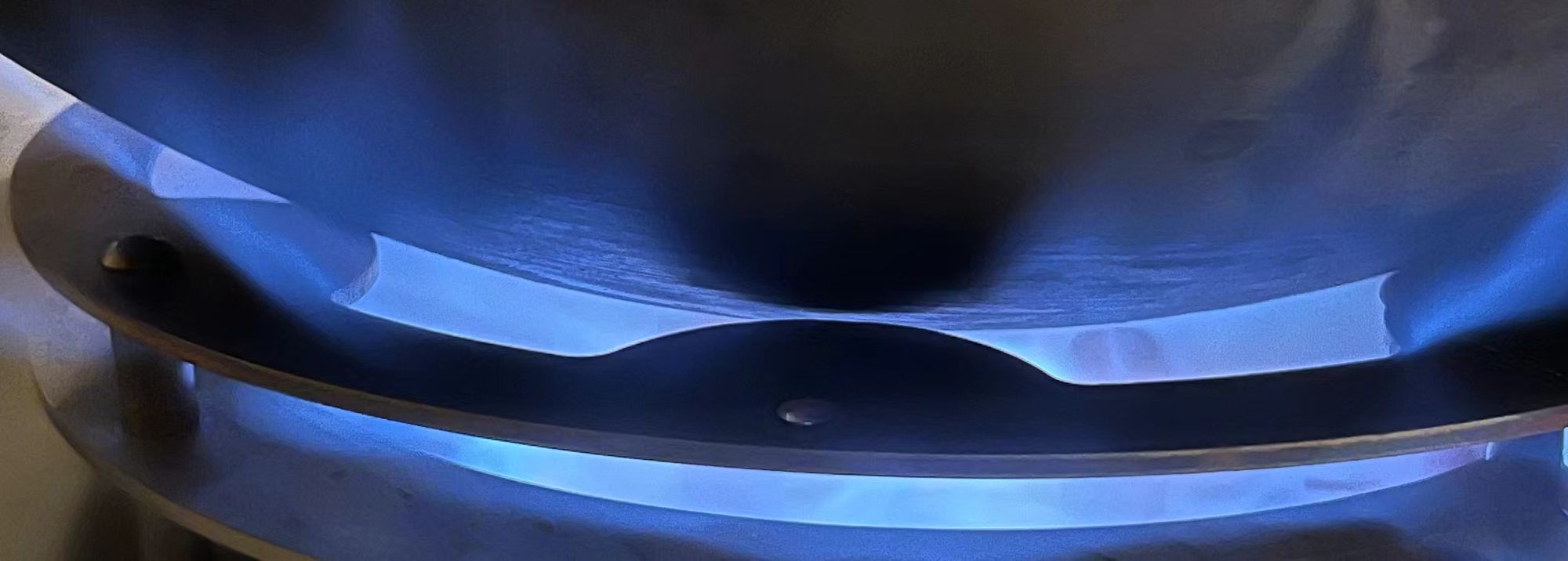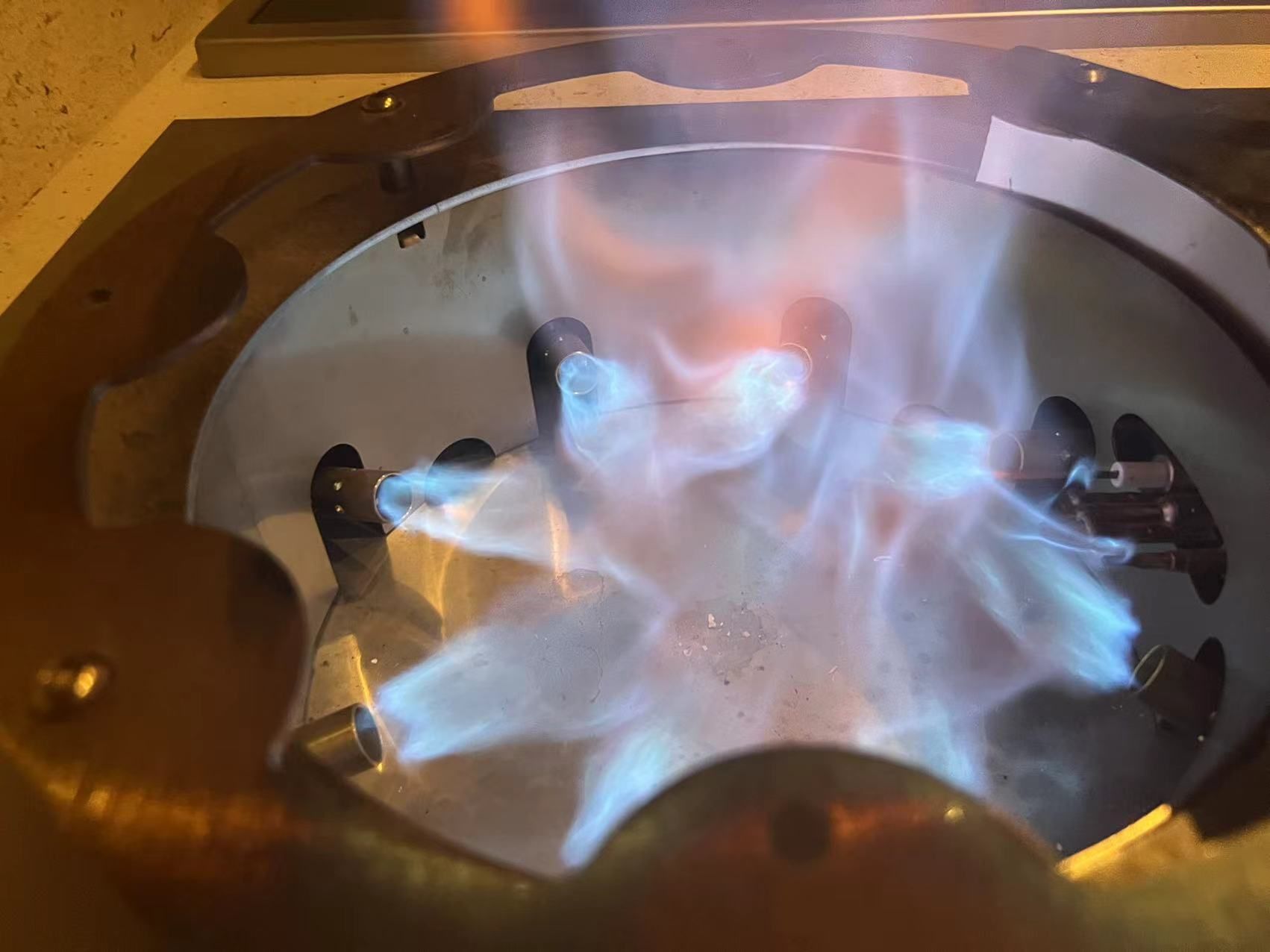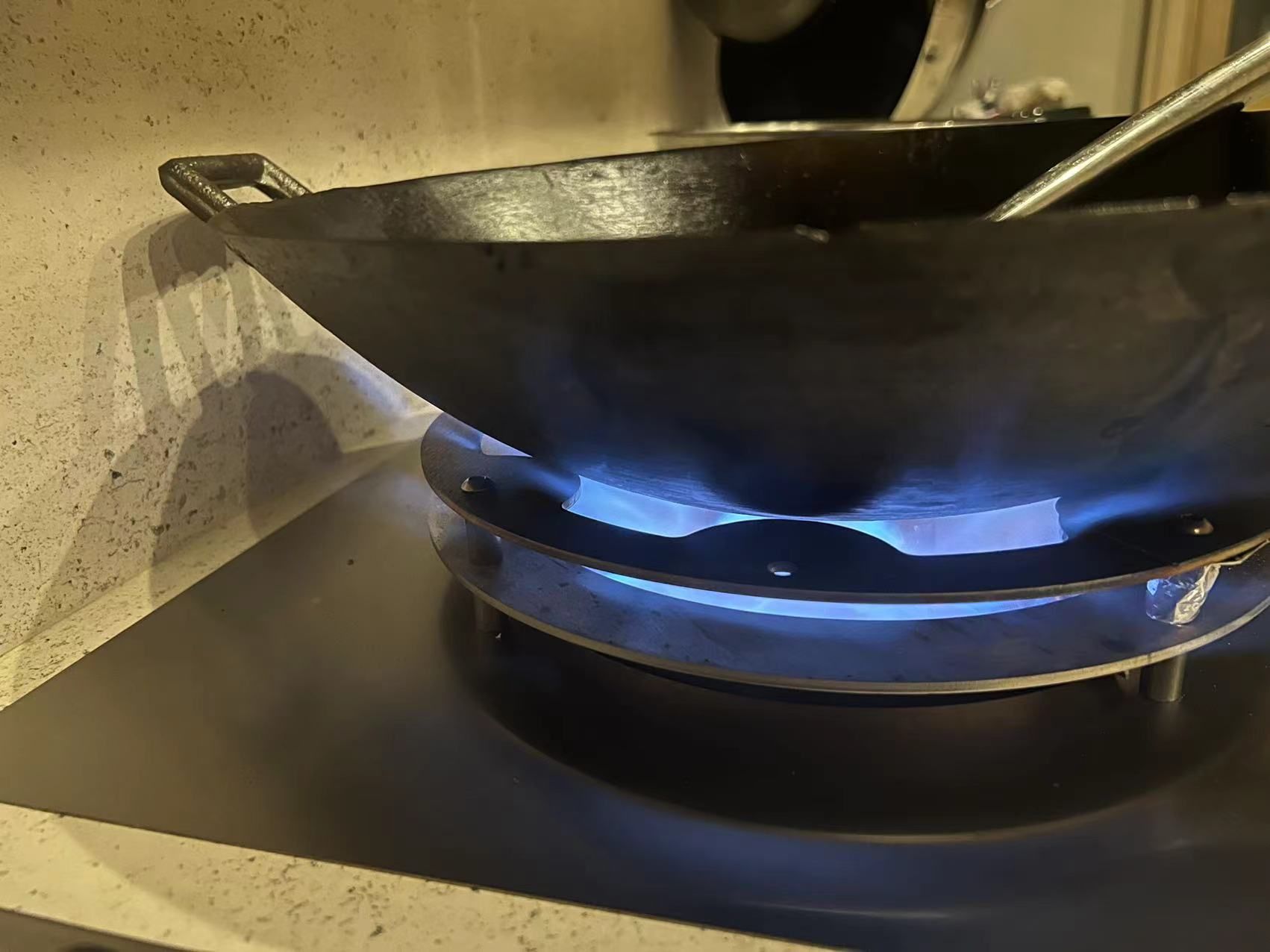Wok burners, WOKits, BTUs and Wok Hei
Finding the best wok burner isn't just about BTUs or Watts.

The British Thermal Unit. A unit of measurement, commonly used in the USA for domestic cooking appliances, that no longer appears to be in common use here in Britain. It's the amount of energy required to raise the temperature of a pound of water by a Fahrenheit. In America, cooktops are measured in BTU/h; here in Europe, we use Watts (Joules per second). However that's not what this blog is about. It's about wok burners, and if you just want to know what's best, skip to the end!
Background
I've spent a fair amount of time learning to cook Chinese-style food, and have had the opportunity to learn from some masters of different cuisines (Sichuan, Cantonese) over the years. I would say I know how to make quite a lot of stuff, my friends say I cook really well, but I'm still not a professional chef and don't pretend to be. During that time I've found a deep level of interest in woks, wok cookers/burners and stir frying in general. I can toss the wok, set things on fire and produce generally tasty stuff. I thought I'd share some of these learnings here.
Much of the internet is filled with endless discussion as to how many BTUs a wok needs and whose name-brand cooktop can produce more BTUs. There's a perpetual desire to get restaurant-type wok cooking into the home, and for the most part it simply isn't possible — and even were it possible, the types of dishes people enjoy in restaurants are cooked in a sufficiently unhealthy fashion that it would be bad for the heart to eat them regularly anyhow, and the mess to clean up wouldn't be worth it.
Restaurant dishes have most ingredients deep-fried first ("passed through oil") — in your beef chow fun, the onions and beef slices are "passed through oil" before being stir fried. The meats are tenderised with baking soda and marinaded with oil too. The mixed vegetables in your vegetable stir-fry dish get rapidly "passed through oil." It makes things taste great — who doesn't think deep fried, tenderised stuff tastes better — but is incredibly unhealthy. Then, already hot from deep frying, the ingredients are stir-fried in a ridiculously hot wok, tossing them into the flames, a process which will dirty a domestic kitchen in no time at all and overwhelm most extractors. In America the dishes are then combined with large amounts of salty or sweet or MSG-enriched sauce — because American ingredients are generally grown for quantity and preservation, so are mostly tasteless by themselves. Often more flavouring oil (味油) is added at the end. Tenderised, oil-marinaded, flash fried, stir-fried, over-sauced, finished-with-oil salty-sweet food: Of course it tastes great! Not all dishes fall into this category, for example steamed fish, congee, poached vegetables and such restaurant food can be incredibly healthy, but most stir-fried ones do, especially those with more sauce.
Back in Hong Kong, people at home don't cook like this. You can watch how much deep frying passing through oil takes place in YouTube videos from chefs like Wang Gang 王刚. In domestic cooking, food is lighter and not routinely deep fried. Less oil and seasoning is used. You'll see Wang Gang adding oil throughout the cooking process in many recipes to keep the wok from drying out, but at home, we add a splash of water instead. Domestic Chinese food is however cooked in a wok, and the hotter the wok, the better it tastes, and the more likely one is to achieve "wok hei" in the cooking — the taste that comes from food being slightly charred and combusting along with the oil. Even on domestic cookers in Hong Kong, with a damn hot wok, one can get some wok hei into home cooking: It's perfectly possible to use a hybrid approach, of high-heat stir-fry without tons of oil and seasoning, with less marinating of higher quality ingredients, to get food that's half way to restaurant taste but substantially healthier.
Living in Europe, the USA and Hong Kong, with time in mainland China too, I've cooked on a variety of different stoves over the years. Starting in Oxfordshire with a flat-bottomed wok on an electric cooker, I've cooked on regular electric cookers, ceramic electric cookers in London, regular gas cookers in the USA, Viking gas cookers in the USA, BlueStar gas cookers in the USA, a variety of domestic gas hobs in Hong Kong, and some gas hobs in Europe too. Except with electric cookers, I've always used round-bottomed, lightweight cast iron woks since round-bottom woks are generally superior for stir frying. Why cast iron? It's what I learned to cook Cantonese food on, it's a bit less likely to warp and need hammering back, and I find one can get away with a bit less oil without food sticking than carbon steel woks.
What's often overlooked in the quest for more BTUs is the efficiency of wok cooking. The best woks for stir-frying have round bottoms and curved sides, making it incredibly easy for heat and flames to end up going around the wok, heating the air instead of the ingredients in the pan. The BTU obsession doesn't take this into account: Woks, fired with rising gas flames, are really super inefficient.
A high-BTU burner is like having a car with a bigger engine, that just spins the wheels more instead of accelerating.
Inefficient burner designs
Restaurant wok cookers may have over 100,000 BTUs (30,000 Watts, and sometimes double even that!) of cooking power. They blast an incredible amount of gas upwards, shooting it at the bottom of the wok. Guards are present around the front of the wok to stop the flames flying out and setting the chef on fire. They roar like jet engines. If one takes the wok out and looks into the depths of such a cooker, there's a cavernous gap of over a foot or more from the burner head to the bottom of the wok, in order to stop too many of the flames shooting up the sides of the wok. Some designs go further and completely surround the wok, building specialist brick or concrete channels into the base of the burner to extract the exhaust air (sometimes fan-assisted) as efficiently as possible, passing it alongside a pot of running water on the way.
Such a deep appliance is impractical in most home kitchens because it won't fit nicely into countertops: Domestic cookers are typically depth-limited due to cupboards or ovens underneath. Here are some of the domestic options I've cooked on.
Regular domestic gas hob

This is your typical, run-of-the-mill cooker. The burners range from 9000 BTU (2600W) to 14,000 BTU (4100W). The smaller burners work well, the large one tends to leave a little bit of a cold spot at the bottom of the wok due to the flames pattern, but so long as the wok is moved around a bit, this works fine. The power, however, is far too low to stir-fry with any chance of getting a nice charred taste, and putting too much cold food into the wok will lead to it boiling instead of frying. Some people are being ripped off to spend extraordinary amount of money on low-cost metal accessories (the gross margin on these things is probably 95% or more) that probably cost almost nothing to produce to try and remedy this problem, but, at the end of the day, you've got the wrong stove. If you want such an accessory, you can just fasten and bend some sheet metal yourself or have a handy mate do it for you. I'm loathe to add a link to said accessory here, for fear someone might actually buy it.
Big round burner

The Viking series of cookers have higher power output, and it's what I had in my first flat. Some of them have open rather than sealed burners, which leads to a slightly nicer flame pattern. The problem with these is the burners are ginormous, resulting in a cold spot at the bottom of the pan.
Their wok ring made this even worse, lowering the wok closer to the burner head, pushing flames even further up the side. Burned, smoking foods on the side of the wok with a pool of tepid water at the bottom. I solved the problem by making two small pieces of aluminium sheet metal to direct some of the flames from the front sides of the burner to the middle. It worked, but wasn't ideal. Power output was getting better, coming in at something like 17,000 BTUs (5,000W) but still too much heat was lost up the sides of the wok, warming it in places where no food was pleasant.
Star burner

At the next place I lived, I purchased a BlueStar range top. I was mostly looking for a superior flame pattern, having got fed up of the Viking shooting heat up the sides of the wok. The ideal option would be to design space for some sort of dedicated wok cooker, but this would have been a waste since the kitchen had been newly renovated. This burner has a star pattern, with more flames concentrated towards the bottom of the burner, and the grate could be removed to drop a round-bottomed wok straight in. Power output was 25,000 BTU (7,300W). This worked well, and it was possible to re-create the same stir-fry results as on a domestic hob in Hong Kong. I did experiments with putting in a larger gas orifice, allowing more air to mix with the fuel, and drilling out some more holes in the burner. It was not possible to get much more power output (30,000 BTU, around 8500W) until the flames shot too far up the sides of the wok, forcing the use of a wok ring on top of the stove and a flame guard in the front, so the handle didn't burn, which started to look messy.
Standard dual stacked burner hob

This is the standard burner design used on domestic cookers in parts of Asia I've been to, and some models in the USA and Europe have also adopted the approach. Some are simpler and just have a simple inner and outer burner, but work about the same. The inner burner is designed to place flames as close to the bottom of a round-bottomed wok as possible, and the flame pattern on the outer burner tries to avoid the flames shooting up the sides. These burners are actually quite efficient: The handles of the wok don't get burned, the wok can get incredibly hot, and the chef won't catch fire. They offer up to around 21,000 BTU (6000W) of power output, almost the same as the BlueStar, yet a high quality, glass surfaced three-burner range top only costs around US$500 and a low-cost one even less. It's crazy that in the West, more power output means more money, yet the cost of goods is about the same. Despite the same power output as the BlueStar, the wok gets even hotter at the bottom, and this does a pretty good job overall.
Elevated double-drilled burner

One of my kitchens had a Miele CS1028 wok burner, which featured an elevated, sealed burner with holes drilled for flames on an inside ring as well as outside. Don't let the power, at 27,500 BTU (8000W) fool you: The results were not particularly satisfactory since the inner flames were so tiny that the bottom of the wok was far colder than the sides. Almost all Miele products I have had, from vacuum cleaners to dishwashers, ovens and washing machines, are amazing. This is the only exception I've seen so far. It was a let-down, yielding burned food on the sides of the wok with a lukewarm patch on the bottom. I believe the product is now discontinued.
The WOKit PowerBlock

I chose to save the best for last. After a huge amount of research to design a new kitchen in Europe, I stumbled upon a brilliant product from engineer Markus Seidt in Germany at Brennermanufaktur. The WOKit is CE rated for indoor and outdoor use, and has a free-standing/countertop, floor-standing and built-in model available. It produces a colossal 48,000 BTU (14,000W) of power, yet magically manages to focus this power at the bottom of the wok, without the flame shooting up the sides. Best of all, it's 100% made in Germany, not expensive compared to most of the products above, and some proceeds from all sales are sent to Vietnam to help children suffering from Agent Orange exposure. Markus's first design was also very deep, requiring a large amount of space between the burner and the wok to shoot the flame, but the subsequent design was small enough to fit into a normal countertop — probably the most shallow, high output wok burner in the world.
Jet burner heads are directed horizontally, towards the perpendicular edge of an imaginary circle in the bottom of the burner chamber. The flame pattern forms a tornado, allowing more combustion air to be drawn in and and twirl round and round in circles, rather than straight upwards. This allows the jets to burn for a longer distance without shooting too high, swirling around the bottom of the wok. The handles of the wok don't get too hot either. It's hard to see the tornado effect in a still photo, but here it is as well as a photo showing 48,000 BTUs directed at the bottom of my domestic-sized 40cm (15.75") cast iron wok:


I believe this to be the best compact wok burner in the world, small enough to incorporate into a kitchen, and easy enough to carry around. Its unique flame pattern means it's about as efficient as you can get with gas: Many reviewers on German wok forums have seen it out-performing outdoor propane stoves with twice the power rating. In practice, for domestic sized woks rather than the huge restaurant ones, you'll get the same effective heat into the bottom of the wok as professional chefs are cooking with.
Needless to say, such a device requires an incredibly powerful extractor, at least 2000 m3/hr (1200 cfm) and preferably as much as 12500 m3/hr (1500 cfm) if you're setting things on fire, aggressively tossing the wok, or adding water/wine to oily food. Even with such an extractor, cleaning up the splatter is a lot of work... just one more reason why cooking like a restaurant at home is more effort than it's worth. Just eat out!
Others
I've cooked on some incredibly powerful propane outdoor burners which do the job well: They waste a lot of heat with flames shooting up, but it's easy to allow a lot of vertical space and it's cheap to acquire incredibly powerful devices.
I've cooked on some residential wok burners in the US, such as the Viking dedicated 24" model, but the power output of such things is almost the same as the BlueStar, so it's not worth the extra dedicated space. Wolf's new integrated wok burner cooktops look interesting. It's not possible to find the flame pattern online, but it looks like the flames point upwards and it's showing as $5600 for a single wok and two burners!!!! Insane gross margin on this stuff!!! There's no way it'll work better than my WOKit which was 20% of the price and more powerful. My BlueStar will basically never die anyway — those things are incredibly well made — so not worth messing with.
I've also acquired an induction, round-bottomed wok burner which is being installed in the next month or so. I'll be trying it out next year sometime, with a round-bottomed cast-iron wok too... maybe electrical wok cooking with a round-bottomed wok will finally become practical!
Conclusion
Don't sweat power output; focus on flame pattern... and if the WOKit is available where you are, acquire it — there's nothing better out there!
